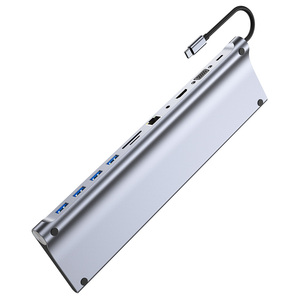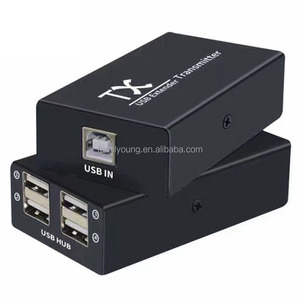(2287 products available)










































































































































































































An Ethernet hub 4 port acts as a central point for networked computers. All data is sent to the hub, which broadcasts it to every connected computer. The hub receives information from any of the computers and sends out a response, thereby allowing them to communicate with one another or join the internet. While the 4-port Ethernet hub can connect up to four computers, this number can be increased by connecting additional hubs, creating a larger network. However, a major downside of hubs is that they are less secure because data sent out can be received by any computer, so they are often replaced by switches.
There are different types of Ethernet hubs depending on what the network requires. They include;
Versatile Connectivity:
An Ethernet hub with 4 ports enables connection to a variety of devices in a network, such as PCs, printers, IP cameras, and network-attached storage devices. This allows devices to communicate with one another and share resources through wired connections.
Network Expansion:
The primary function of a 4-port Ethernet hub is to expand a network by adding more Ethernet devices. It does this by providing multiple ports for devices to plug cables directly into the hub. A hub connects all ports, allowing seamless interaction among connected devices.
Data Transmission:
An Ethernet hub enables data transmission between networked devices. It receives data packets from one device and broadcasts them to all other connected devices so they can communicate directly. However, it's worth noting that hubs send data to all ports, regardless of the intended recipient. This is called data transmission.
Notable Transmission Speed:
Ethernet connectivity comes with standard transmission speeds, typically 10/100 Mbps (megabits per second). This speed depends on the type of Ethernet cable used and the maximum supported by connected devices. While hubs provide basic connectivity, switches are more efficient in terms of speed and efficiency.
Simple Setup:
Ethernet hubs are easy to set up and use. They typically don't need any special configuration to work. Simply plug the hub into a power outlet, connect devices with Ethernet cables, and the hub allows them to communicate.
Cost-Effective Solution:
For basic networking needs, an Ethernet hub 4 port is a good and inexpensive option. It provides wired connections that are often more reliable than wireless and can help devices share resources without requiring additional equipment.
Ideal for Small Networks:
With four ports available, an Ethernet hub is perfect for small home or office networks where only a few devices need to be connected. It brings the benefits of wired networking and connectivity, making it a functional asset for small-scale networking.
An Ethernet hub 4 port is a versatile device that provides network connectivity for various industries and activities. Some of its prominent applications include;
There are a few things to consider when choosing a 4 port Ethernet hub.
Management Capabilities
A 4 port Ethernet hub is generally known as an unmanaged hub if it doesn't provide any management functionalities. Unmanaged hubs provide basic connectivity and expect devices to communicate and determine network pathways independently. Unmanaged hubs are typically used in home networks or small businesses where advanced network management is unnecessary.
Network Regionalization
Unmanaged hubs are often used for regionalization, which involves dividing a network into smaller, more manageable sub-networks. By connecting regionalization to unmanaged hubs, organizations can improve network performance, security, and management. Unmanaged hubs allow for easy expansion of network access, providing a simple solution for connecting devices in different regions or locations within an organization's network. Regionalization helps to focus network issues on specific areas, making troubleshooting and problem-solving more efficient. Additionally, by segmenting the network, organizations can enhance security measures and better manage network resources.
Port Speed and Power Over Ethernet
When determining which Ethernet Hub to purchase, think about the speed of the ports and whether or not Power over Ethernet (PoE) is required. The hub's port speed refers to how quickly data can travel through the hub, while PoE means that the hub can supply power through the Ethernet cable to powered devices like cameras or wireless access points. PoE can be useful because it means that powered devices can be placed where they are needed without having to find out where the nearest power outlet is.
Shopping the 4 port Ethernet hub
When choosing a 4 port ethernet switch, it is essential to consider vendor reputation, product reviews, warranty and support, product certification, and compliance, as well as additional features and functionalities. Evaluating these factors will help make an informed decision and choose a reliable and high-quality product that meets specific networking requirements. Vendor reputation is a critical factor to consider when choosing a 4-port Ethernet switch. Opt for a vendor with a proven track record in the industry and recognized for providing reliable networking equipment. Research the vendor's reputation by reading reviews and ratings from other customers. A reputable vendor is more likely to offer quality products and satisfactory customer support.
Q1. Is there any difference between an Ethernet hub and a switch?
A1. Yes, there is a significant difference between an Ethernet hub and a switch regarding network connectivity. Ethernet hubs operate on Layer 1 of the OSI model, which is the physical layer; they merely replicate incoming signals and send them to all ports. In contrast, Ethernet switches work at Layer 2 (the data link layer) of the OSI model and are much smarter than hubs because they store and forward frames based on MAC addresses.
Q2. What is the difference between a hub and a switch in networking?
A2. The main hubs and switches' differences in networking are their functionalities and capabilities. As mentioned previously, hubs are simple, focusing more on broadcasting signals, while switches intelligently direct data packets only to the intended recipient, thereby reducing unnecessary traffic and increasing network efficiency.
Q3. What is a 4 port Ethernet hub?
A3. A 4-port Ethernet hub is an Ethernet network device that connects up to four computers or other devices to create a local area network (LAN). This allows these connected entities to communicate and share resources such as files or an internet connection.